Self-propelled gun mount 15 cm sIG 33 Sfl. auf Pz.Kpfw.I Ausf.B / Sturmpanzer I (Germany)
Shortly before the outbreak of war in Europe, the German command raised the question of developing promising artillery systems that could significantly increase the mobility of guns. Particular importance was attached to the creation of heavy weapon carriers, such as 150-mm 15 cm sIG 33 guns. This gun was put into service in the 1933 year and was produced only in towed version. As a result, the mobility of artillery units equipped with such systems left much to be desired. The troops needed self-propelled equipment capable of carrying similar and other weapons.
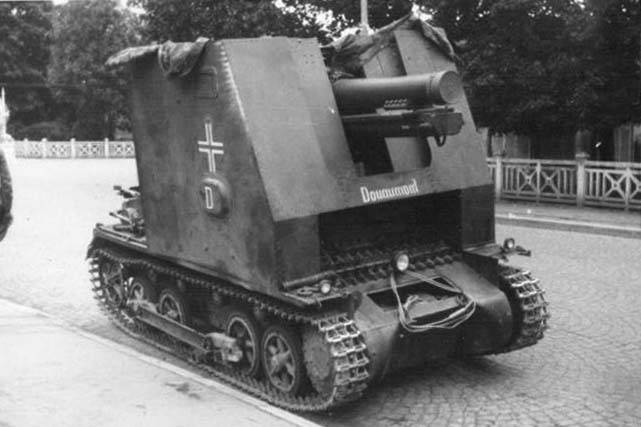
SAU 15 cm sIG 33 Sfl. auf Pz.Kpfw.I Ausf.B during the French campaign. Photo Aviarmor.net
Due to the restrictions imposed by the current situation and existing plans for the production of military equipment, Germany was not able to develop a new chassis for the sIG 33 from scratch. Nevertheless, the military and designers managed to find the opportunity to create the required self-propelled guns. It was suggested that one of the available lungs be used as the basis for it. tanks. The troops had several hundred Pz.Kpfw.I armored vehicles of various modifications, which no longer fully met the requirements for tanks, but could be used in new projects. Such an approach allowed relatively quickly to give the army the required self-propelled guns with the necessary weapons, as well as to do without unnecessary expenses. In the future, such a technique was supposed to be replaced by machines of newer models, originally developed in accordance with the requirements.
The proposal to remake the Pz.Kpfw.I serial tanks of the Ausf.B version into 150-mm cannon carriers was approved at the end of the 1939 year. Soon the development of the project started, which consisted in changing the design of the base chassis in order to use it together with the tool. Due to some of the limitations imposed by the design of the base products, the result of the project was the appearance of an armored vehicle with a characteristic appearance and specific characteristics.
In accordance with the German notation, the new ACS should have received a name describing the basic units: 15 cm sIG 33 Sfl. auf Pz.Kpfw.I Ausf.B. In addition, additional names have been proposed Sturmpanzer I and Bison ("Bison"). In the future, the name "Shturmpanzer" was transferred to some other projects of similar technology.
In order to save time and resources, it was decided to save part of the basic chassis units, as well as equip it with some new details. To accommodate the armament and the reservation required for it, Pz.Kpfw.I Ausf.B removed the upper part of the hull along with the turret. As the floor of the new fighting compartment is now proposed to use a horizontal roof. Other units of the hull, as well as the layout of the internal volumes, almost did not change. In front of the car remained transmission, behind which there was a driver, and the feed was allocated under the engine and its auxiliary systems.
The body of the future self-propelled gun, borrowed from the base tank, retained the existing reservation. Its frontal part consisted of several sheets with a thickness from 8 to 13 mm, the bead and the feed - 13 mm. In addition, the existing armored hull was supplemented with a deckhouse to protect the guns and gunners. On the front of the roof, it was proposed to mount a U-shaped unit in plan in terms of sheets of 14,5 mm thickness. The front part of the cutting house had a sloping frontal sheet with a vertical cut-out for the gun, and under the sheet there was free space, which was proposed to be used to observe the road from the driver’s seat. Were applied to the board of complex shape with beveled front faces. The back of the sides was hinged and could deviate to the side to facilitate falling into the wheelhouse. Behind the frontal leaf of the cabin there should have been a regular gun shield.
The power plant and transmission of the new machine were saved without any noticeable improvements. The Maybach NL 38TR hp 100 carburetor engine was placed in the rear of the car. The engine mated with a manual transmission based on the main and side clutches, six-speed manual gearbox and belt brakes. The transmission of the car was connected to the front drive wheels.
The chassis was also borrowed from the light tank Pz.Kpfw.I Ausf.B without any changes. There were five rubberized rollers on each side. The front pair of rollers was equipped with an individual spring suspension, the rest were blocked in pairs and received leaf springs. A characteristic feature of the tank undercarriage and the new ACS at its base was the use of external beams covering the four rear support rollers. The front wheels were attached to the drive wheels, in the stern - guides. There were also four supporting videos.
To simplify the production of serial equipment, it was decided not to change the design of the gun carriage of the desired gun. The use of 150-mm gun sIG 33 was proposed together with the standard wheel carriage, which was based on a single-box box-type machine. During the assembly of the self-propelled gun, it was proposed to roll onto the roof of the hull, while the carriage wheels were placed in special boxes, and the frame was fixed with special locks placed on the roof of the engine compartment. After such a fastening tools self-propelled guns could perform the tasks. To facilitate the installation or replacement of guns, the armor house could be dismantled relatively quickly.
150-mm heavy infantry gun arr. 1933 G. sIG 33 was equipped with a barrel length 11 caliber and had a horizontal sliding gate. The mast design allowed the gun to be aimed in a horizontal plane within 11 ° to the right and left of the neutral position. Vertical guidance was performed in the sector from -4 ° to + 75 °. Hydropneumatic anti-recoil devices were used. The gun sIG 33 could use separate loading ammunition with several types of projectiles. When using the lightest high-explosive fragmentation projectile type I.Gr. 33 provided an initial speed of up to 240 m / s. The maximum firing range reached 4,7 km. A trained calculation could do up to 3-4 shots per minute. Together with the gun carriage, the Rblf 36 telescopic sight was also retained.
The large size of the gun and the relatively small dimensions of the base chassis led to a sharp reduction in the payload. In the packing, placed on the roof of the hull, managed to place only eight shells with sleeves. Thus, for a full-fledged combat work, the new SAU 15 cm sIG 33 Sfl. auf Pz.Kpfw.I Ausf.B needed a carrier for ammunition. In addition, it became extremely difficult to shoot on the go because the car required regular stops to replenish the ammunition.
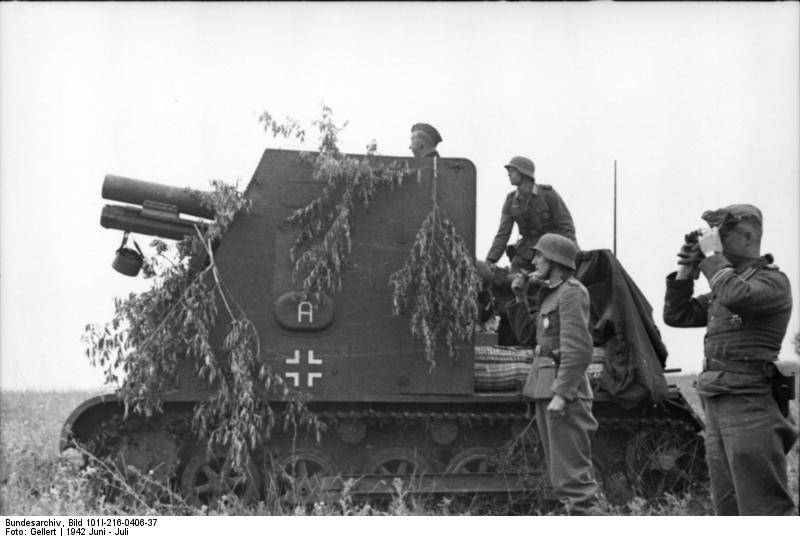
Operation of the machine in the military, summer 1942 g. Photo by Wikimedia Commons
Additional weapons new project was not provided. If necessary, the crew of self-propelled guns had to use personal small weapon. Also, the gunners should rely on the assistance of accompanying troops.
The crew of the promising self-propelled guns included four people. Inside the case, under the established tool, there had to be a driver. As already mentioned, due to the installation of a new armored cabin, he had to watch the road through a large “window” in the lower part of the frontal sheet. The commander of the SAU, who was also assigned the duties of a gunner, was placed to the left of the gun, next to its sight and manual guidance drives. For the supply of ammunition had to answer two loaders.
The prospective self-propelled artillery mount was noticeably larger and heavier than the base light tank. The length of the vehicle was 4,67 m, width - 2,06 m, height - 2,2 m. The combat weight was equal to 8,6 t. 1750 kg weighed a gun and about 5800 kg was the mass of the machine itself. About a ton more was accounted for fuel, crew, ammunition, etc. For comparison, the base tank Pz.Kpfw.I Ausf.B had a height of 1,7 m and weighed only 5,8 t. Due to the weight increase and preservation of the power plant, the SAU Sturmpanzer I could reach speeds of no more than 30-35 km / h. Power reserve was limited to 140 km.
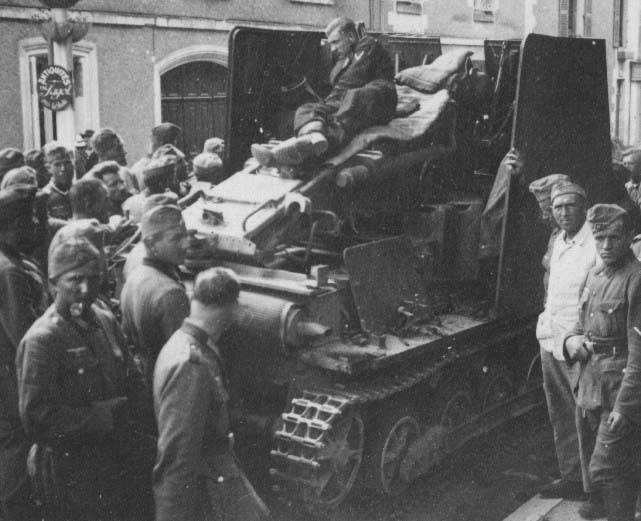
German soldiers and self-propelled gun "Bison". You can consider the features of the installation tools. Photo Aviarmor.net
In January 1940, one of the light tanks available was rebuilt according to a new project. 29 January this car presented to the test. In addition, simultaneously with the ACS, the customer was shown a promising ammunition transporter, also made on the basis of the Pz.Kpfw.I Ausf.B tank. The transporter differed from the base machine by the absence of the turret and the liberated fighting compartment, within which it was now proposed to transport only projectiles of various types.
Tests have shown that the promising machine 15 cm sIG 33 Sfl. auf Pz.Kpfw.I Ausf.B “Bison” has ambiguous characteristics. The use of 150-mm guns with the highest firepower allowed to solve a wide range of combat missions and to destroy various targets, including fortifications with good protection. At the same time, the military was not fully satisfied with the large combat mass of self-propelled guns, the inadequate level of defense of the gunners and the deteriorated mobility. In addition, the reason for the claims was excessively high centering of the machine, which could lead to coups on different slopes.
The customer, represented by the Wehrmacht, weighed all the pros and cons of a new combat vehicle, after which he decided on further work. Despite the dubious characteristics of mobility and protection, it was decided to adopt an ACS 15 cm sIG 33 Sfl. auf Pz.Kpfw.I Ausf.B into service. The industry ordered an assembly of 38-like machines. To produce a new technique was the company Alkett.
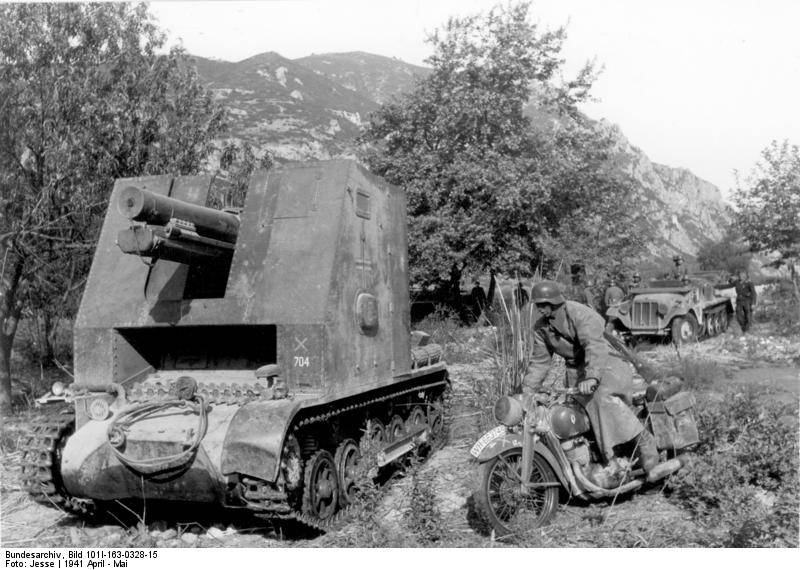
On the roads of Greece, 1941 g. Photo by Wikimedia Commons
All ordered vehicles were handed over to the troops by the summer of 1940. This technique was distributed among several companies of heavy infantry guns. Each such unit, divided into three platoons, included six Bison self-propelled guns, 12 tractors Sd.Kfz.10 and six motorcycles to provide communication. Initially, companies armed with new self-propelled guns were not part of larger units. Subsequently, they were handed over to the command of several divisions.
Before the attack on France, six companies equipped with 15 cm sIG 33 Sfl. auf Pz.Kpfw.I Ausf.B, were distributed among several tank divisions, which were to participate in the battles. At the same time, companies of heavy infantry guns were attached to small brigades as part of divisions. Already after the transfer of new self-propelled guns to the tank divisions for the first time took part in the battles.
During the fighting on the territory of France, the German army showed high combat capability, one of the consequences of which was the small casualties of the mouths of heavy guns. For all the time of the fighting with the French army, the enemy destroyed only two Sturmpanzer I self-propelled guns. According to reports, one of them, who was working on the front line, was noticed by the enemy observers, who pointed artillery at her. The reasons for the loss of a second car are unknown.
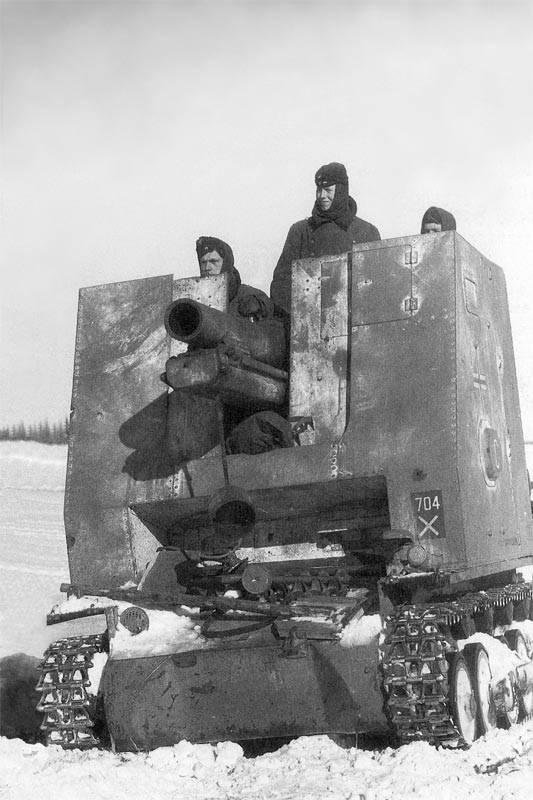
SAU Sturmpanzer I differed a great height. Photo Aviarmor.net
It is noteworthy that the non-combat losses of the ACS 15 cm sIG 33 Sfl. auf Pz.Kpfw.I Ausf.B were significantly higher than combat. Due to the large weight and the need for constant movement of the machine experienced increased load on the power plant and chassis, leading to their breakdowns. It is known that 22 of May (that is, after 12 days after the start of battles) the command of the 703 heavy weapons company reported the impossibility of full-fledged combat work: because of damage to the undercarriage, only one machine with an 150-mm gun remained in combat-ready condition. The remaining self-propelled guns needed urgent repairs.
Almost all self-propelled guns of the Sturmpanzer I survived the French campaign. Soon, similar machines from three companies had to fight in the Balkans and participate in the seizure of Greece. As far as is known, there was no loss of combat losses and the number of combat destroyers did not change, although some of the vehicles needed repair.
During the attack on the Soviet Union, German troops used only a small number of 15 cm sIG 33 Sfl remaining in service. auf Pz.Kpfw.I Ausf.B. In 1941, only the 705th and 706th companies of heavy infantry guns were sent to the Eastern Front. In the summer of 42nd, the 701th company also went to war. Thus, no more than 18 Bison self-propelled guns participated in battles with the Red Army at a time. At the same time, the number of such machines was constantly changing. Despite the high firepower, these self-propelled guns were equipped with relatively weak armor and were a fairly easy target for artillery and aviation. Over time, approximately by the end of 1943, the German command decided to completely abandon the use of self-propelled guns Sturmpanzer I due to moral and physical obsolescence.
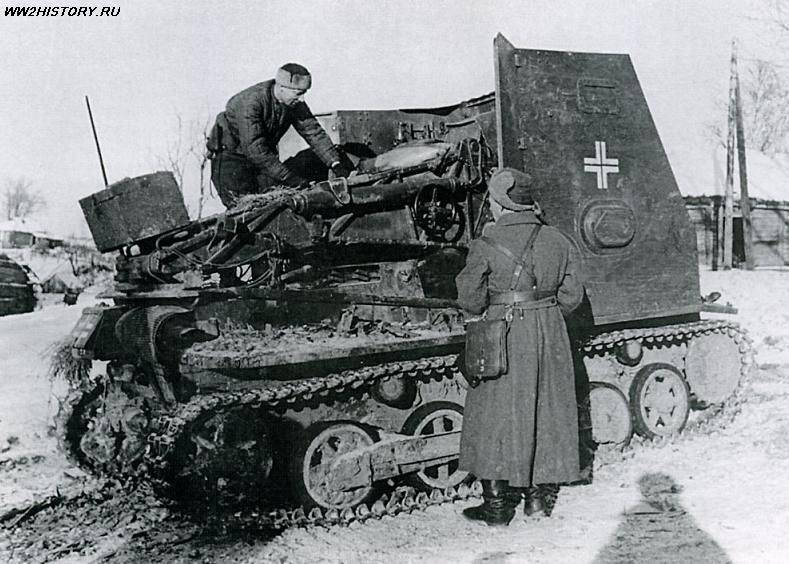
Soviet officers study the captured German self-propelled gun, December 1941. Photo Ww2history.ru
The further fate of the combat vehicles remaining in the troops is not known for certain. Probably, the equipment with the developed resource was sent to the rear and then went for disassembly. Repair, restoration and return to service were inexpedient, and in some cases impossible for technical reasons and due to the lack of some necessary spare parts.
According to reports, at least one self-propelled Bison was captured by the Red Army in the whole form. This car, like other trophies, was sent to the landfill for testing and careful study. Inspections showed that the car is hopelessly outdated and has no advantages with the exception of powerful tools. It is known that in parallel with the trophy 15 cm sIG 33 Sfl. auf Pz.Kpfw.I Ausf.B Soviet specialists studied the self-propelled gun StuG III. Estimates of these two machines were diametrically opposed.
The project of a self-propelled artillery installation based on the Pz.Kpfw.I Ausf.B tank and 15 cm sIG 33 guns was created as an “ersatz” designed to quickly supply the army with the required equipment. Due to this origin, the project did not have special requirements for the main characteristics. At the same time, an aging tank with not very high characteristics was used as a base for the machine, which led to the corresponding consequences. At the beginning of the 1940s, the 15 cm sIG 33 Sfl self-propelled gun was once considered a good and promising. auf Pz.Kpfw.I Ausf.B is hopelessly outdated and is no longer of interest to the troops. In addition, by this time several new cars of similar purpose with high performance were created. "Bison" fulfilled its task and was no longer needed by the army.
Based on:
http://achtungpanzer.com/
http://aviarmor.net/
http://lexikon-der-wehrmacht.de/
http://wwiivehicles.com/
Chamberlain P., Doyle H. Complete reference book of German tanks and self-propelled guns of the Second World War. - M .: AST: Astrel, 2008.
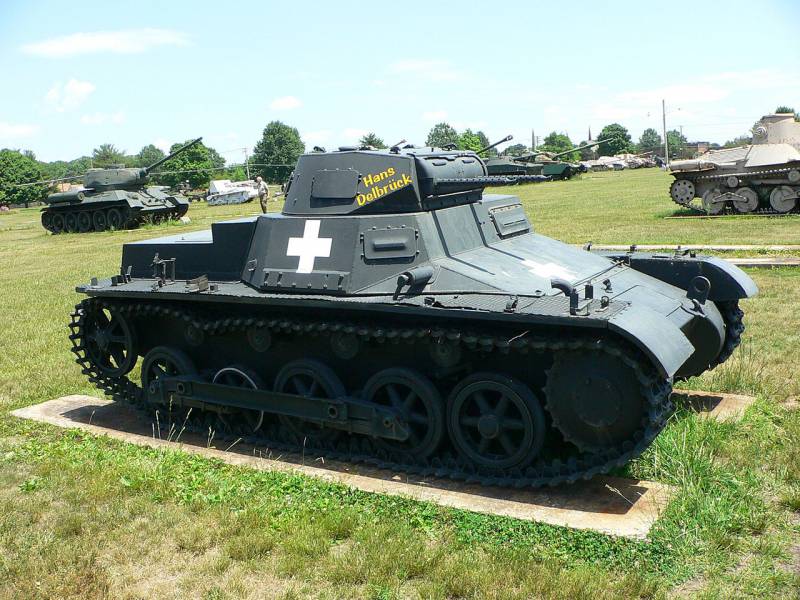
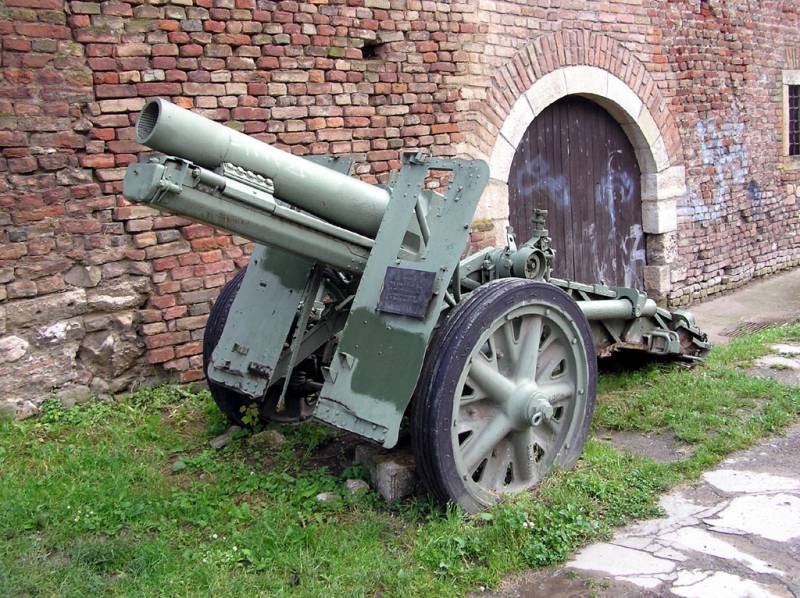
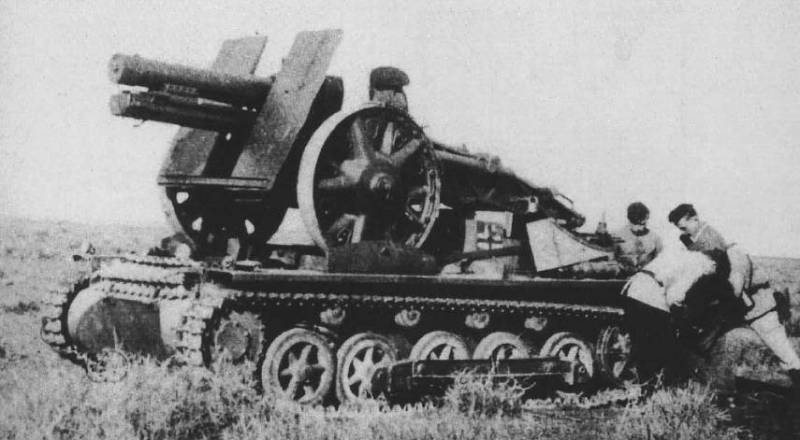
Information